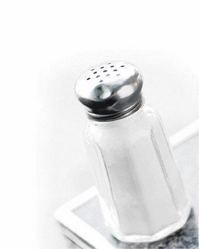The sodium monster
Published: Wednesday | September 2, 2009

DIETITIAN'S DESK
Chronic non-communicable lifestyle diseases (CNCD) have emerged as the leading causes of morbidity and mortality in Jamaica. Hypertensive diseases are among the top causes of death in women and men.
To reduce the risk of high blood pressure and heart diseases, it is recommended that the dietary intake of sodium be reduced. Based on the evidence of the study, 'Dietary Approach to Stop Hypertension', the National Heart Lung and Blood Institute of America developed the DASH diet. This diet emphasises high intake of fruits and vegetables (as these foods are high in potassium and magnesium, which are beneficial in blood pressure regulation and control) along with a low-fat, limited animal-protein diet and limited sodium.
The accepted dietary recommendation for sodium is 2,300-2,400mg per day (about one teaspoon of salt). For people with heart disease, the recommendation is even stricter, at not more than 2,000mg of sodium intake per day.
High-sodium foods
Most of the salt consumed daily is not from table salt added in cooking or at the table. Processed foods are big culprits. Pay attention especially to the following:
Salted fish
Cured meats
Canned meats and fish
Dehydrated soups and mixes (cup soups and bag soups)
Powdered seasonings
Soy sauce
Canned soup
Canned vegetables and beans
Frozen dinners
Frozen pizza
Marinades and dressings
Breakfast bagels and pancake mixes
Crackers and cookies
Many brands of bottled water.
How to reduce sodium
1. Consume more unprocessed foods.
2. Buy low-sodium versions of packaged foods.
3. Use fresh or frozen vegetables instead of canned.
4. Purchase low-sodium soups.
5. Limit cured meats or foods packed in brine.
6. Season with fresh herbs instead of powdered versions with added sodium.
7. Limit instant foods, such as instant rice mixes.
8. Rinse and drain canned foods, such as canned vegetables.
Read labels
Look out for the word 'sodium' on the ingredients list. Additives, such as sodium chloride, sodium citrate, sodium bicarbonate are a few examples.
Sodium free means less than 5mg per serving; low sodium - 140mg or less per serving; very low sodium - 35mg or less per serving; reduced or less sodium - at least 25 per cent less per serving than reference food; light in sodium means if food is low calorie and low fat, the sodium is reduced by at least 50 per cent.
Additional tips
An increase in fruits and vegetables is beneficial as it increases potassium, calcium and magnesium intake, which is essential in regulating blood pressure. Adding whole grains, low-fat dairy and reducing weight if you are overweight are also beneficial. The intake of alcohol should also be limited. Vegetables should not be overcooked or leached in water, as large amounts of potassium will be lost.
Making these changes can go a far way in reducing sodium in the diet, controlling high blood pressure and preventing morbidity, and even mortality.
Rosalee M. Brown is a registered dietitian/nutritionist who operates Integrated Nutrition and Health Services; email: yourhealth@gleanerjm.com.



